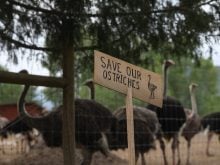Rodenticides intended to kill gophers in southwestern Saskatchewan are also taking a toll on songbirds, weasels, badgers and coyotes, a wildlife researcher says.
Gilbert Proulx, who is studying the efficacy of gopher poisons for Alpha Wildlife Research and Management in Sherwood Park, Alta., said poisons such as strychnine and blood thinners have helped reduce gopher populations in southwestern Saskatchewan, but improper use is also causing secondary poisoning in predators.
“With the poisons that are being used, maybe not always in the best manner nowadays, a lot of predators are being killed,” said Proulx, a former adjunct professor at the University of Alberta.
Read Also

VIDEO: Agritechnica Day 4: Robots and more robots, Nexat loves Canada and the trouble with tariffs
Agritechnica Day 4: Robots and more robots, Nexat loves Canada and the trouble with tariffs.
“I know very well that there are areas in southwestern Saskatchewan right now where you cannot find weasels or badgers. Everything has been killed there.”
Secondary poisoning occurs when predators scavenge on the carcasses of gophers that have eaten poisoned baits.
Non-predatory species, such songbirds, are also eating the baits, which often contain a poison liquid applied to wheat, barley or oats.
It is difficult to estimate the extent of secondary poisoning, but evidence is widespread.
“There’s a lot of poisons on the field, so you see the loss of several bird species … a lot of songbirds and a lot of bigger birds like geese and so on,” Proulx said.
“Poisons by nature are not too selective so it’s (important) how we apply them …. If you put too much on for too long, then you kill all types of things.”
According to Saskatchewan Agriculture, farmers in the province spent $2.6 million on gopher poisons last year and received rebates worth $1.3 million through the province’s Gopher Control Rebate Program.
Proulx said indiscriminate use of poisons is a misguided approach to reducing gopher populations.
“We’re not talking about the extermination of gophers here. We’re talking about control, and the best method of control is to help the predators to take over those populations rather than trying to replace the predators altogether.”
In some parts of Saskatchewan, residents have reported that farmers are applying poisoned baits from all-terrain vehicles equipped with a hopper.
Proulx said careless application of poisons could come back to haunt prairie farmers.
“It’s this type of behaviour that has caused the loss of some poisons in the past,” he said.
“We don’t want to repeat our mistakes. We have to be careful.”
Carolyn Gaudet, a habitat stewardship co-ordinator with Nature Saskatchewan’s Operation Burrowing Owl, said secondary poisoning is a potential threat to the province’s burrowing owl population, although the organization has not received specific complaints of secondary poisoning deaths.
The owl, whose Canadian range stretches from southwestern Manitoba to Lethbridge, has been endangered since 1995.
The grasslands of southwestern Saskatchewan are considered its core area.
Nature Saskatchewan received a report of a dead burrowing owl in early June, but the cause of death has not been determined.
According to recent estimates, roughly 200 burrowing owl pairs are left in Saskatchewan.
Proulx was contracted to study the efficacy of gopher poisons and to compare the use of poisons with natural predation.
He said strychnine, anticoagulants and some types of gas are providing good gopher control, although the efficiency of different products varies under different field conditions.
“There is not one poison that is good for everything, so farmers should have a toolbox (with multiple items) and depending on the situation, they should use different poisons.”
He also stressed that proper application is critical to minimizing secondary poisoning in wildlife, pets, songbirds and waterfowl.
“We have found evidence that the burrowing owls are feeding on ground squirrels, so if you’re not being careful with your poisons, you (might be) making the case worse for those birds.”
Proulx’s research, which is funded by the Saskatchewan government and the Saskatchewan Association of Rural Municipalities, will continue throughout the summer.















